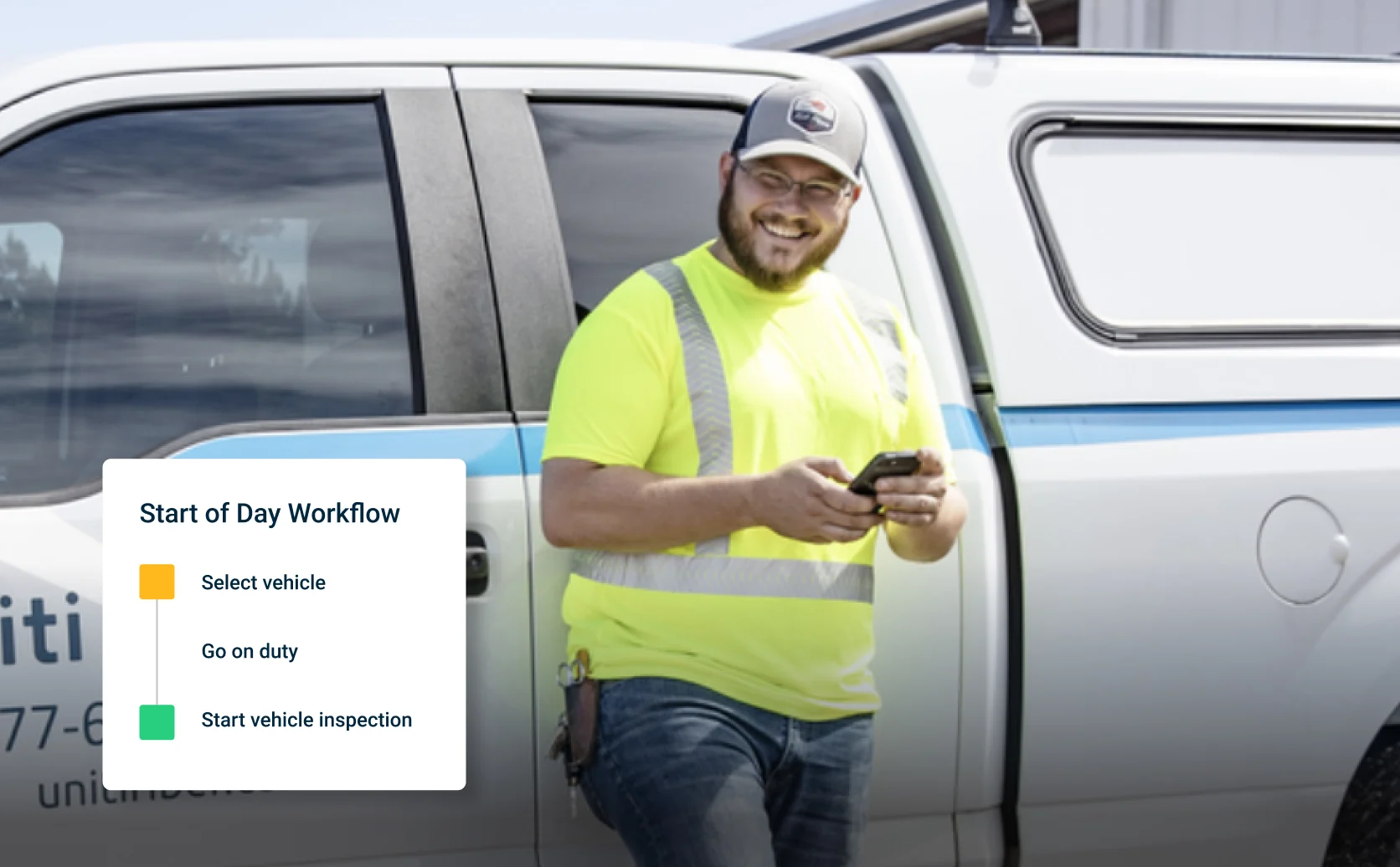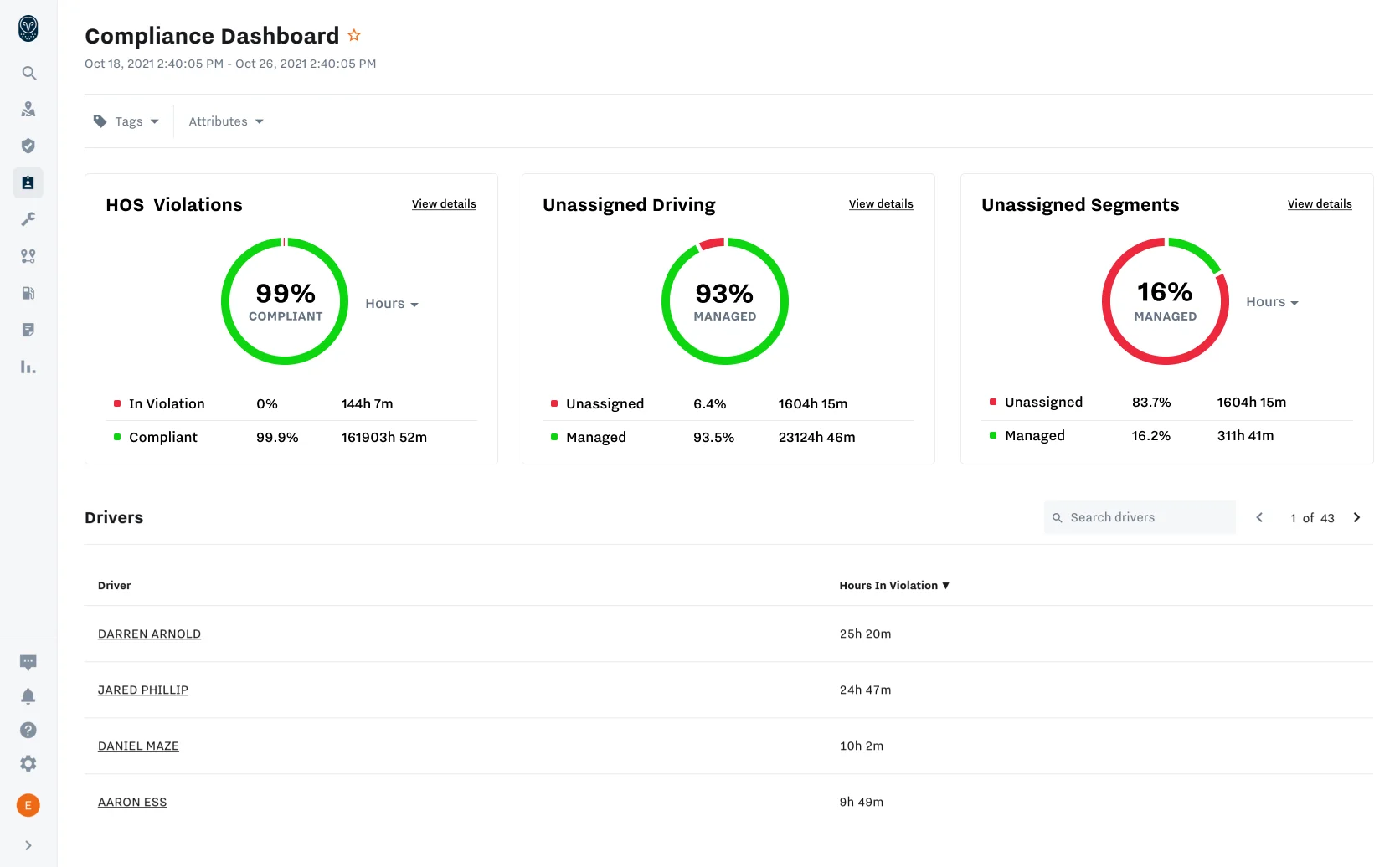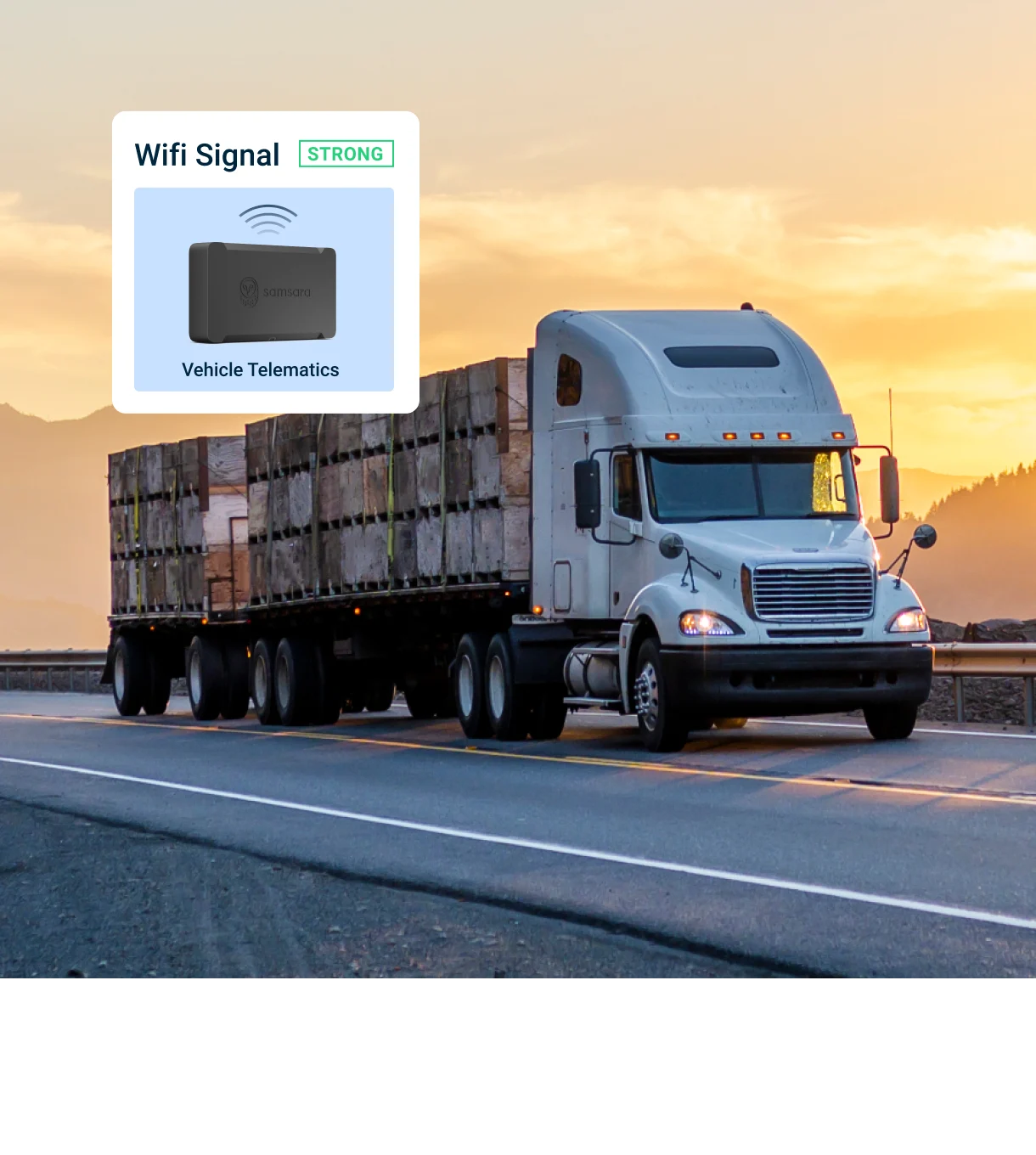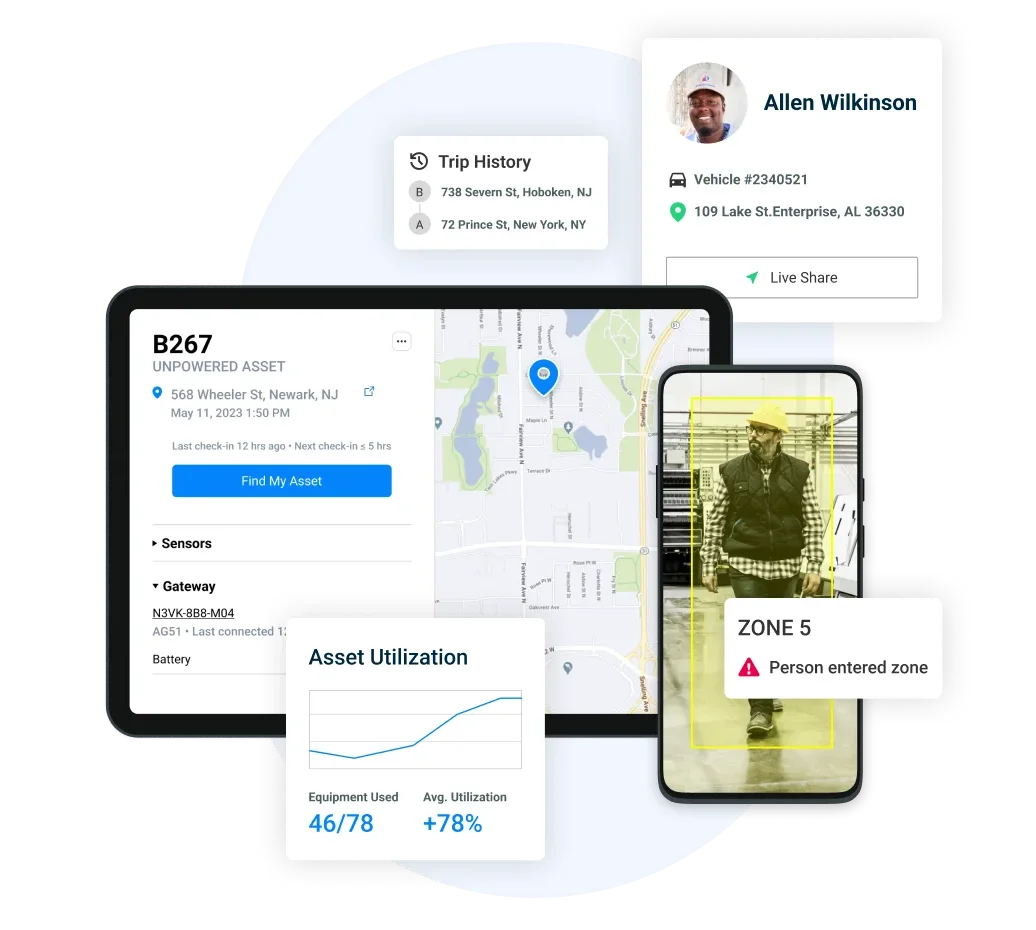ELD Compliance
An FMCSA-registered and third-party certified ELD for full compliance in the U.S. and Canada

Connected Operations Cloud
Take ELD compliance to the next level with the Connected Operations Cloud
Intuitive HOS Logging
Simplify the driver experience with intuitive tools to stay safe and compliant
Streamlined Log Management
Save time and prevent HOS violations with real-time insights and automated workflows
“The drivers find the app very intuitive. It’s easier for them to log their hours which makes the work of our back office easier, too.”
Greg Sikorski
Director of Transportation Safety and Compliance, KeHE Distributors

What is Canadian ELD mandate?
The Canadian ELD mandate—much like the U.S. FMCSA’s ELD mandate—requires commercial motor vehicle operators to use electronic logging devices (ELDs) to log Hours of Service (HOS). The mandate was announced on June 13, 2019 and will go into full enforcement on January 1, 2023. The ELD mandate aims to increase road safety by annually avoiding thousands of crashes, saving lives by reducing driver fatigue, and saving billions of dollars in paperwork expenses.
Unlike in the U.S., where the FMCSA instructs ELD providers to register and self-certify that their ELDs meet functional requirements, Transport Canada’s ELD mandate requires providers to submit their ELDs to an accredited third-party certification body. A progressive enforcement period will last from June 12, 2021 through January 1, 2023. During this period, motor carriers will be encouraged to use ELDs, but there will be no penalties for carriers or drivers who do not have a certified ELD during this time. Instead, enforcement officials will focus on elevated education and awareness programs.
Who must comply with the Canadian ELD mandate?
The Canadian ELD mandate applies to all federally regulated motor carriers, including US-based fleets that cross the border into Canada. A motor carrier is federally regulated if one or more vehicles in the carrier’s fleet operates in multiple provinces or territories. A motor carrier is provincially regulated if every vehicle in the fleet operates exclusively within a single province or territory. Once a motor carrier is federally regulated, all of the carrier’s regulated drivers must comply with Federal Hours of Service (HOS), i.e. even those drivers within the fleet that never leave one province/territory. Provincially regulated motor carriers fall under provincial jurisdiction and are not subject to the federal ELD mandate. Read more.
What happens if a motor carrier doesn’t comply with the Canadian ELD mandate?
Failure to comply with the Canadian ELD mandate can have serious implications, including costly fines, suspensions, and negative impacts to your safety rating.
However, electronic logging devices (ELDs) collect many types of data beyond driving time and records of duty status that are helpful for fleet management. Without this data, you may miss opportunities to improve the safety, efficiency, and sustainability of your operations. For example, data from ELDs can be used for:
Dispatch and routing: Built-in GPS tracking in the ELD provides real-time location information, enabling you to see exactly where all your vehicles are at any given time, without having to call your drivers.
Maintenance: Because the ELD plugs into a vehicle’s onboard diagnostics (OBD) port, it is able to pull critical engine data—like mileage and fault codes—for scheduling preventative maintenance and responding quickly to reactive repairs. Samsara's ELD solution comes with an all-in-one Driver App, which drivers can use to complete electronic Driver Vehicle Inspection Reports (DVIRs). Paperless DVIRs help drivers save time while giving you real-time visibility into vehicle repair needs.
Safety: A built-in gyroscope and accelerometer can detect harsh events—like harsh braking, harsh turning, and collisions. Safety and GPS data can be particularly powerful when paired with AI dash cams, giving you full incident details to exonerate innocent drivers from false claims.
Security and loss prevention: Samsara offers geofencing capabilities that allow you to create a virtual boundary around any location, like a yard or terminal. Then, leveraging your ELD’s real-time GPS capabilities, you can be alerted any time a vehicle leaves your geofence—making it possible to proactively detect potential security issues or theft.
Fuel savings and sustainability: You can use engine diagnostic data from your ELD to get visibility into fuel usage and idling trends. With Samsara, you can see idling time and harsh events by driver or vehicle, enabling you to more effectively coach drivers, reduce fuel costs, and minimize risky driving behavior.
When did the Canadian ELD mandate go into effect?
The Canadian ELD mandate will go into full enforcement on January 1, 2023, at which point commercial motor vehicle drivers must use a third-party certified electronic logging device (ELD) to log Hours of Service (HOS). This means all recording devices must be third-party certified ELDs and on-board recording devices (AOBRDs) or paper logs will no longer satisfy the mandate.
Although commercial motor vehicle drivers will not be subject to penalties for operating without a certified ELD prior to that date, experts recommend that you start your ELD transition early. Not only will an early adoption approach help you smooth the transition for your team, but it means you can also deploy workflows that increase efficiency across your entire operation. Read more about how you can prepare your fleet for the Canadian ELD Mandate.
Do I need GPS tracking to be ELD compliant?
Yes; because electronic logging devices (ELDs) are required to record a vehicle’s location, ELDs have GPS tracking built-in. ELDs with real-time GPS tracking, like Samsara’s ELD solution, can provide real-time visibility into driver logs and vehicle locations, helping you improve dispatch operations and serve customers more efficiently. Read more.
How can I get my drivers on board with ELD compliance?
Complying with the Canadian ELD mandate isn’t just about procuring an ELD device; it’s also about preparing your drivers with the proper training to avoid compliance issues during inspections.
Here are tips to equip your employees for success with ELD compliance:
Provide proper training on ELDs: Make sure drivers know how to sign in, sign out, and certify their e-logs with their ELD. Proper training is critical to keeping everyone compliant. It's especially important that drivers remember to sign out at the end of their shift so that their off-duty time is logged.
Practice roadside inspections: While training drivers on how to use the ELD is important, you also want to ensure they are prepared for a roadside inspection. Make sure your drivers know how to transfer ELD data to inspection officers and run through the steps of an inspection to get drivers comfortable with the process.
Verify that vehicles have the correct in-cab materials: In order to avoid violations, make sure every driver has an in-cab kit with the ELD user manual and DOT inspection card.
Encourage drivers to annotate their logs: By having your drivers leave remarks on their duty status, they create a historical record of what happened that day. Annotations come in handy in cases of unassigned drive time or when managing special duty statuses and provide a helpful record during audits.
Why should I pick Samsara as my ELD provider?
Samsara’s ELD solution is certified by accredited certification body FPInnovations, confirming compliance with the Canadian ELD mandate. This means Samsara’s ELD has been verified to meet compliance requirements through both road testing and bench testing in hundreds of scenarios, enabling customers to be confident that they’re using a solution that helps them stay fully compliant with both the U.S. and Canadian ELD mandates.
Samsara’s ELD solution is also part of Samsara’s Connected Operations Cloud, a consolidated platform for vehicle telematics, video-based safety, equipment monitoring, and site visibility, so you can seamlessly switch between compliance, fleet management, safety Dash Cams, vehicle maintenance, dispatch, and more.
Additionally, we understand that preparing for an ELD mandate is a significant undertaking—one with which we at Samsara are familiar. We helped thousands of fleets in the U.S. make the transition when the U.S. ELD mandate first went into effect in 2017. From that experience we learned that implementing the right ELD affords you an opportunity to transform your operations.
No matter where you are in your ELD transition process, Samsara is here to help you succeed. Our in-house team partners with customers to provide implementation, training, and support services. Read more.
Who is exempt from ELD regulations?
There are four main exceptions to the Canadian ELD mandate. Commercial motor vehicles are exempted if they:
Operate under a specific permit.
Operate under a statutory exemption.
Are subject to a short-term rental agreement (those with a term of 30 days or less).
Were manufactured before 2000.
Additionally, the ELD mandate does not apply to commercial vehicles that do not operate outside of a 160 kilometer radius of their home terminal (i.e., motor carriers do not need to acquire and install certified ELDs for such vehicles). However, the moment that the vehicle travels outside of this 160 km radius, it must use an ELD. Read more.
Can truck drivers still use paper logs or AOBRDs?
When the Canadian ELD mandate goes into full enforcement on January 1, 2023, commercial drivers subject to Canadian Hours of Service regulations can no longer use paper logs to track Hours of Service (HOS) and must use a third-party certified electronic logging device. The ELD mandate was passed as a way to ensure that commercial drivers have a safe work environment and to create an easier system to track and manage records of duty status (RODS). Read more.
How can ELD violations be prevented?
The best way to prevent ELD violations is to use an intuitive, reliable ELD compliance solution. One of the most commonly cited roadside inspection violations is “unable to perform data transfer,” largely because drivers may be unfamiliar with how to transfer logs to inspection officers. To avoid violations, choose an ELD solution that’s easy for drivers to use.
Samsara's ELD connects directly to a vehicle's engine through the OBD port. Live data is transmitted to the ELD so there is always an accurate log of when the engine is on and what speed the vehicle is traveling, as well as diagnostic information, such as engine fault codes, and safety information, such as instances of harsh braking or acceleration.
Drivers then record their Hours of Service (HOS) and certify their e-logs through the Samsara Driver App. Together, the engine data and the driver's records of duty status form a complete picture of compliance with the ELD rule. The Samsara dashboard gives you real-time visibility into drivers' driving status, the amount of time until their rest break, and the number of hours left in their driving period, and logbooks, helping you quickly identify drivers approaching an HOS violation. Read more.

Streamline the driver experience
Empower drivers with an all-in-one mobile app for ELD, messaging, dispatch, documents, DVIRs, and more.

Increase driver safety
Build a world-class safety program with dash cams, driver safety scorecards, and coaching tools.










